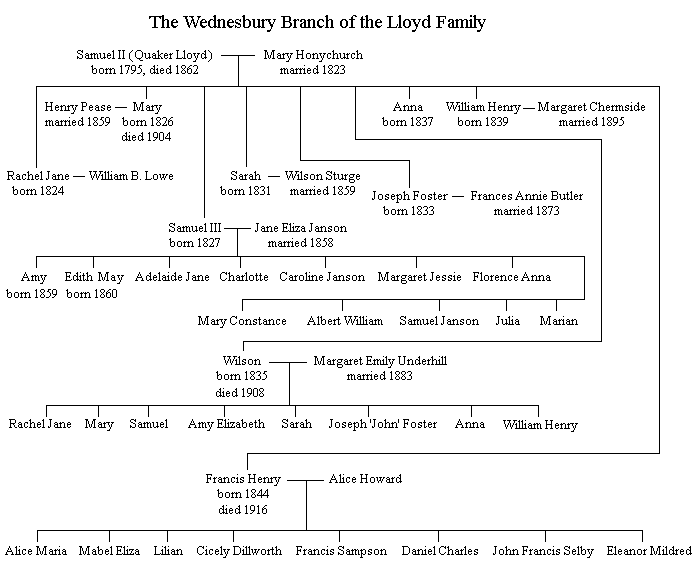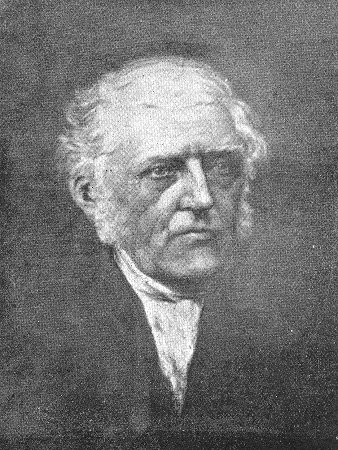|
The Lloyds of Wednesbury
The family’s first link with Wednesbury
began when Sampson II married Sarah Parkes in 1727. Her
father, Richard Parkes, of Oakswell Hall, Wednesbury, which
he acquired in 1689, was a wealthy landowner, who owned a
lot of coal mines in the area. He also had a 500 year lease
on the Wednesbury mines owned by Richard Shelton and others.
At the time the mines were regarded as
being of no value because of constant flooding, and so the
owners thought themselves fortunate that Richard Parkes
would pay for a lease, for what to them was valueless. Some
years later when mine pumping engines became commonplace,
this would all change.
Richard Parkes died in 1729 and left
his estate to be equally divided between his four daughters.
Sarah Parkes’ share of the estate came into the possession
of the Lloyd family, and was inherited by her only child,
Sampson Lloyd III, who also inherited an estate in
Wednesbury that belonged to his cousin Betsy Fidoe.
Sampson’s son, Samuel I, born in 1768,
devoted himself to the family’s banking interests. In 1818,
his son Samuel II, who became known as ‘Quaker Lloyd, came
to live in Wednesbury at the age of 23, in order to exploit
the family’s land for coal and iron production.
After Samuel’s arrival in Wednesbury,
one of the principal landowners, who inherited his land from
his late father, Richard Shelton, the man who agreed to
lease his mining rights to Richard Parkes, contested it on
the grounds that no mining had been carried out in his
father’s lifetime. Now that steam pumping engines were
commonplace, coal could be profitably mined in the area for
the first time, and so the mining rights became a valuable
asset.
In 1818 a Chancery suit to settle the
question was instigated by Richard Parkes’ heirs. Lord
Eldon, the Lord Chancellor, was extremely slow in giving
judgments. Three years later he had still not made a
decision on the matter, and so the dispute was settled out
of court. Once this had been done, mining operations quickly
got underway, and the firm of Lloyds, Fosters & Company was
formed to oversee the operation.

A Newcomen pumping engine, of the type
improved by Smeaton, and Watt was installed near Hobs Hole.
It successfully drained water from a seam of coal eight feet
thick, and about 60 feet below the surface. The land also
contained iron ore, which the company smelted, and clay,
from which was made bricks and tiles. The firm also ran
Ball’s Hill and Mounts Collieries, and in about 1825 began
smelting the ore at Old Park Works. The output soon amounted
to half of the production of pig iron in the town.

Samuel Lloyd
II "Quaker Lloyd". From
"Wednesbury Faces, Places & Industries". |
|
Old Park Works rapidly grew in size. By
1851 products included railway wheels, railway turntables,
and steam engines. Initially the wheels were fitted to axles
made by the Patent Shaft & Axletree Company, but in 1854
when that company also began to make wheels, Lloyds started
to make their own axles in a forge and plate mill built
especially for the purpose at Monway Fields.
The new factory
called The Monway Axle and Tyre Works
produced axles, tyres, and iron plate for boilers and
bridges. At the same time a third blast furnace was
built at Old Park to supply the extra iron.
In 1849 Lloyds were the first firm in
Staffordshire to adopt furnaces using hot blast, which saved
10,000 tons of coal a year. In 1857 the efficiency of the
furnaces was again improved by using the waste gases to heat
the blast. |
Just before Samuel
Lloyd’s death in 1862, he signed an agreement with Henry
Bessemer for the use of the Bessemer process, which the
company began to use in 1865. This was the first factory in
the Black Country to make mild steel, at a time when Old
Park Works were the largest steel works in the area. By 1866
over 3,000 people worked there. The introduction of mild
steel was an important factor in the demise of malleable
iron production in the area.
Samuel Lloyd, or
"Quaker Lloyd" as he was known, had been a good employer.
His kindness could be seen from the help that he gave to
widows and orphans of employees who lost their lives in the
company's collieries. He also opened the British and Foreign
Society School in 1820, in the old Quaker Meeting House in
Lower High Street, and was involved in parish affairs. He
also began a successful campaign with the Rev. Isaac
Clarkson to suppress bull baiting in the town, and became a
member of Wednesbury’s Local Board in 1852, becoming
Chairman in 1853.
Like many factories,
Old Park Works issued tokens as part of the employees’
wages, known as truck payment. The tokens could only be
spent in the company’s tommy shop. Many employers did this
as a way of exploiting their workforce by charging high
prices in their shops, and sometimes selling inferior goods.
Lloyds, Fosters’ shop was very different, providing only the
best quality goods at low prices, often lower than in shops
in the town centre. The shop sold the best meat in town, and
Samuel Lloyd took great pride in buying articles and food
from the shop himself, particularly tea and meat.
|

The Lloyd family in 1860,
on the lawn of the family home, The Hollies.
Back row left to
right: Wilson Sturge, Sarah Sturge (neè
Lloyd), Wilson Lloyd,
William Henry Lloyd, Anna Lloyd, Joseph Foster
Lloyd, Mary Pease (neè
Lloyd), and
Samuel Lloyd.
Front row left to right: William Lowe,
Rachel Lowe (neè
Lloyd), "Quaker Lloyd",
Mary Lloyd, Henry Pease, and Elize Janson
(neè Lloyd).
|
By the time of
Samuel’s death, the company had become prosperous, and it
looked as though more success would surely follow. Around
the time of his death, the company signed one of its largest
contracts, which would go terribly wrong.
In 1856 the old
London Bridge over the River Thames was demolished, which
greatly changed the tidal currents around the original
Blackfriars Bridge, scouring the sediments, and making the
bridge unsafe. This led to its demolition in 1860, and the
planning of a replacement bridge. A new bridge was designed
by William Cubitt, and the contract for its construction put
out to tender. The lowest tender, received from P. A. Thom &
Company was accepted, and work soon got underway.
The company ordered
the necessary ironwork from Lloyds & Fosters and agreed to
pay cash monthly for each delivery. A contract was signed,
and the first batch of ironwork was sent to London. At the
end of the month, after delivery, no payment arrived. P. A.
Thom were unable to pay, and sent a note agreeing to settle
their debt in four months, which again was never paid.
Samuel Lloyd junior strongly advised the company to cease
deliveries at once, but the shareholders, who at the time
owned three quarters of the shares, ignored his plea, and
decided to finance the contractor.
P. A. Thom & Company
were having great difficulties in finding a solid foundation
for the stone piers which had to be sunk into the
London clay below the bed of the river. The daily tides made
the job much more difficult than anticipated, and work
progressed at an extremely slow pace. There were also
problems at the northern end of the bridge, where the Fleet
Ditch had been pouring water into the river for thousands of
years, softening the ground to such an extent that no solid
base could be found. It took another two years before the
bridge opened, but by this time Lloyds, Fosters & Company
had gone.
By 1867 Lloyds, Fosters & Company had
lost a quarter of a million pounds on the operation, and
were forced into liquidation. The company was sold to the
Patent Shaft and Axletree Company Limited, which did so well
on the deal that in seven years the profits were sufficient
to pay the whole of the purchase money in dividends.
Samuel Lloyd junior left Wednesbury for
Birmingham after joining his cousin, Edward Rigge Lloyd, son
of Isaac Lloyd, to set up the firm of Lloyd & Lloyd, at the
Albion Tube Works in Nile Street, Birmingham, in 1859. They
manufactured boiler tubes, and were pioneers in the
production of large diameter, gas-welded, wrought iron and
steel tubes. In 1870 they took over Henry Howard & Company,
owners of Coomb Wood Tube Works at Halesowen, and in 1903
joined forces with tube maker A. & J. Stewart Limited, to
form Stewarts and Lloyds Limited.
Sampson Lloyd, “Quaker Lloyd’s”
brother, was secretary of Wednesbury Mechanics Institute
which began life in an old house known as “Old Library
House” on Church Hill, next to the gates of St.
Bartholomew’s Church. It later moved to Russell Street.
When the vicar at St. Bartholomew’s,
Isaac Clarkson built a new vicarage by the parish church,
Sampson rented the old vicarage, opposite the Old Leathern
Bottle pub in Vicarage Road. In 1851 Sampson and Edward
Elwell junior became trustees of the Wednesbury Benefit
Building Society, later known as Wednesbury Building
Society. |